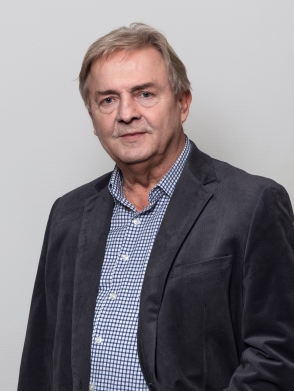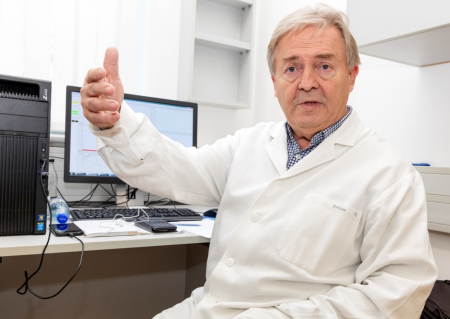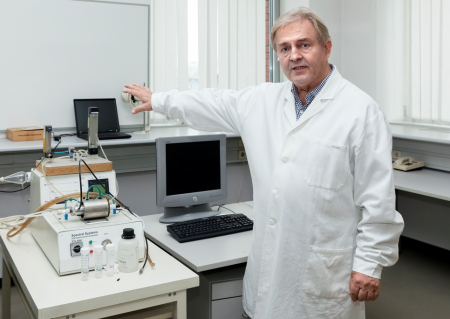
Professor Gyula Záray, project leader (ELTE)
The NVKP_16 programme provides funding for R&D activities in the frame of cooperative projects involving universities, research institutes and domestic companies in order to create internationally competitive products, services and technologies in sectors of strategic importance from the perspective of Hungary’s competitiveness, such as medical and material sciences as well as water-health-food. The consortium, awarded with a grant in 2016 in the frame of this programme, and formed by the ELTE Cooperative Research Centre for Environmental Sciences (ELTE KKKK), the Research Centre for Natural Sciences of the Hungarian Academy of Sciences (MTA TTK) and two enterprises, set the objective of developing a new technology to disinfect biologically treated wastewater and remove organic micropollutants. To achieve this goal, traditional disinfecting methods using ultraviolet radiation will be combined with the photolytic oxidation procedure. In this project, the two research teams will provide a solid experimental background, whereas the participating companies will support the individual stages of the development in a mutual, constant and efficient assistance.
Why is micropollution caused by hardly detectable pharmaceutical residues interesting? “Many argue that one litre of water contains only a few nanograms of these contaminants. Thus, in order to ingest the amount of the active ingredient comprised in a tablet approximately 10 thousand litres of water should be consumed”, thinks professor Gyula Záray project coordinator, director of the ELTE KKKK. – “This is absolutely true, but with the aid of advanced analytical techniques, the traces of different types of xenobiotics can also be detected, as it was confirmed by the analyses carried out in several other countries in the world. There is no knowledge on the long-term synergistic effect of these diverse compounds simultaneously present in water at trace levels. In England, urban water works report on the content of contaminants detectable in drinking water every year. We could also do with such a report, though some say that this would trigger a panic. I disagree with them, this is something we must talk about openly,” emphasizes Gyula Záray.
The administrated medicines and their metabolites are excreted in the feces and urine and, then discharged into wastewater. In wastewater treatment plants, organic contaminants are primarily degraded by bacteria. These bacteria cope with the degradation of natural substances, but in many cases they do not have the sufficient enzymes to degrade synthetic drug molecules. For example, the concentration of the well-known painkiller and anti-inflammatory drug, diclophenac, is permanently on the increase in the Danube from the Black Forest to the Black Sea. This molecule is extremely resistant to biodegradation, therefore it persists in the aquatic environment for a long time.
The development of “green pharmacy” may lead to bio-degradable drugs, but we cannot predict fast progress. Nevertheless, this question is increasingly important from a future perspective, because due to increased life expectancy, the use of medicines is also on the increase; at the same time, and due to global warming caused by climate change the water yield of the rivers into which the treated water is discharged will be lower. (In Budapest, the diluting effect of the Danube River is between 600 and 1,000 times for the treated wastewater discharged into it, while for smaller settlements, the effluent of the wastewater treatment plants is discharged into creeks, which in the summer usually dries out completely). Today wastewater treatment plants purify water in three steps: mechanic filtering and degreasing are followed by biological degradation, which is followed by chemical or UV disinfection, i.e. the destruction of bacteria. However, in the meantime, certain hardly degradable organic micro-pollutants still persist in water.
Some plants, such as, for example, the Wastewater Treatment Plant in the South of Pest, still apply ultraviolet radiation to disinfection. Partners cooperating in this project currently develop special vacuum UV lamps that can generate radiation with shorter wavelength and higher energy. Since the atoms of mercury vapors slowly diffuse into the quartz sleeve of the lamp at its operating temperature, the lamp efficiency is significantly decreasing after approximately 10,000 operating hours. In order to prevent the diffusion of the vapors of mercury atoms, the inner surface of the quartz sleeve should be coated with an extremely thin but solid aluminium oxide layer. The sol – gel technology aiming at the production of the aforementioned layer is expected to increase the life time of the lamps and emission of photons of 185 nm, as well. In addition, titanium dioxide will be used to catalyze production of hydroxyl radicals and ozone to make the degradation of organic contaminants more efficient. The most important objective of the development is to achieve disinfection and oxidative degradation of organic contaminants at the same time.
First, the model compounds will be subjected to degradation under controlled laboratory conditions, then these experiments will also be carried out on biologically treated water. For these experiments, four active ingredients have been selected (diclophenac, naproxen, carbamazepine, clarithromycin), considering the drug sales figures from Budapest and Pest county and the list of active ingredients recommended by the EU Joint Research Centre for monitoring and reporting based on its risk assessment. (According to the data of the Semmelweis University, only in the central region of Hungary as much as 500-3000 kg of these active ingredients might be used yearly!) In the planned experiments, the degradation of the selected compounds and their removal efficiency will be investigated to be able to evaluate the effect of the proposed innovation on the combined application of vacuum UV radiation and photocatalytic oxidation.
For identification of the molecules found in raw and treated water as well as their quantitative determination, researchers at ELTE will set up a high-performance liquid chromatograph coupled to a highly sensitive quadrupole time-of-flight mass spectrometer (UHPLC-QTOF). “Identifying oxidation by-products is of key importance in this work”, emphasizes professor Záray. - “Currently we work with four compounds only, but in reality we need to take into account the presence of hundreds of contaminants and their degradation products.
 |
 |
“Therefore, we aim to remove organic micro-pollutants from both biologically treated wastewater and groundwater contaminated with organic solvents,” summarises Gyula Záray. “An important task is to be able to achieve degradation of pollutants with the highest possible efficiency and lowest costs by applying oxidative technologies. In addition, it is also mandatory to identify the oxidation by-products produced in these processes and justify the feasibility of the water treatment technology based on ecotoxicological investigations.”
Project details
Awarded project: Developing innovative photo-oxidation water treatment technology to remove organic micro contaminants from biologically treated wastewater (NVKP_16-1-2016-0045)
Duration of the project: 1 February 2017 – 31 January 2020
Project leader: Gyula Záray, professor emeritus
Participants:
- ELTE Cooperative Research Centre for Environmental Sciences
- Lighttech Lamp Technology Ltd.
- Inwatech Environmental Ltd.
- Research Centre for Natural Sciences of the Hungarian Academy of Sciences






